Get rid of Botrytis (bud rot, gray mold) on marijuana. The best ways to stop gray mold fast and prevent it from spreading.
Table of Contents:
- What is gray mold (Botrytis cinerea)?
- What does gray mold look like?
- Where is gray mold found on cannabis?
- Early signs of gray mold
- How fast does bud rot spread?
- How to Stop Gray Mold Fast
- Bud Rot After Harvest
- Is smoking gray mold harmful to humans?
- How do buds get ruined by mold?
- How does Botrytis infection start?
- Bud Rot Sprays
- Cannabis Strains Resistant to Mold
- References
What is gray mold (Botrytis cinerea)?

Botrytis blight, aka bud rot or gray mold, is a fungal disease that affects over 200 plant species. In cannabis, the disease causes a soft rot that damages buds during growth and after harvest.
The agent of gray mold is the asexual fungus Botrytis cinerea. Its name roughly translates to “grape disease” in Greek. Botrytis cinerea is an airborne plant pathogen with a necrotrophic lifestyle. The ability to induce programmed cell death plays a key role in the success of the fungi. [1]
What does gray mold look like?
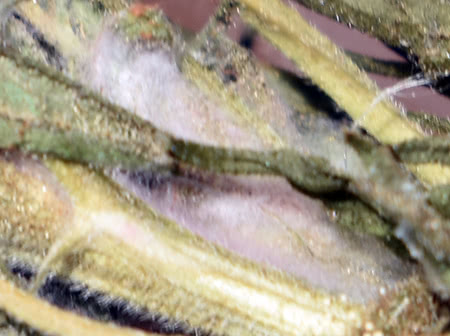
Gray mold appears as a thick carpet of velvety spore mass. Affected plant areas gain a fuzzy web of gray/blue mycelium, visible to the human eye.
As bud rot progresses, the damaged, water-soaked plant material collapses into black mush.
Where is gray mold found on cannabis?
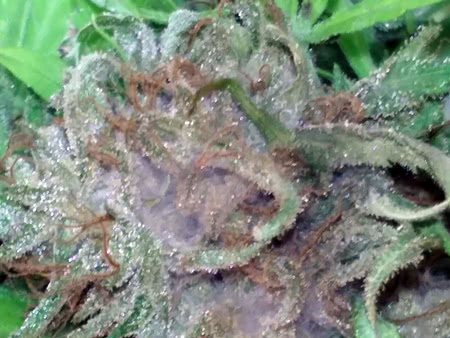
Gray mold occurs in both growing plants and harvested marijuana buds. The disease often starts inside of the bud before spreading outwards. The risk of gray mold infection increases as cannabis matures and its buds grow denser.
Early signs of gray mold
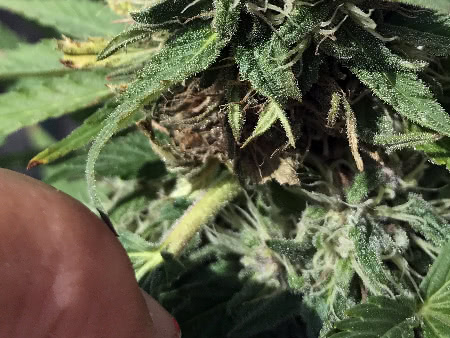
The earliest symptoms of gray mold on cannabis typically appear as small bruises or discoloring of the bud. The bruises collapse into rot, followed by the formation of the mycelium, gray mold.
Other symptoms include yellowing and damping-off of leaves close to the infection. Regular inspection for gray mold can be done by carefully opening buds and checking inside, where gray mold tends to hide.
How fast does bud rot spread?
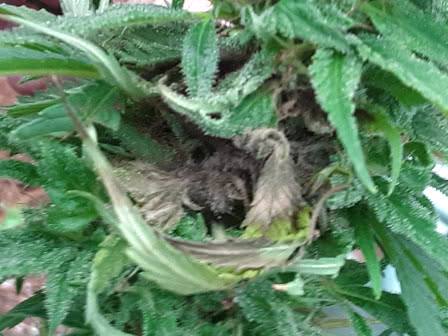
Once established, gray mold spreads quickly throughout the plant. The rate of infection is increased in favorable conditions.
Many times, cannabis plants are nearly destroyed at only a couple of days post-infection.
How to Stop Gray Mold Fast
The disease can be controlled by removing moldy buds, cleaning plants, and adjusting the environment.

Discard Infected Buds
Tools: A knife or scissors dipped in a jar of high purity alcohol (USP grade isopropyl or Everclear), Q-tips, and a garbage bag.
1. Cut out around the damaged area using scissors or a knife dipped in rubbing alcohol.
2. Put the moldy bud in the garbage bag.
3. Clean any freshly exposed damage on the plant with alcohol using the Q-tip.
4. Repeat as necessary. Dip blades in alcohol between cuts.
It’s good practice to solarize the garbage bags full of moldy buds (put them out in the hot sun) to kill any fungi before being disposed of.

Remove Dead/Dying Leaves
Botrytis can survive as sclerotia (a mass of hyphal threads) or mycelium on dead plant material such as leaf litter.[3] By remaining dormant, the fungi can wait until it has the chance to attack a living host plant.
Removing dead and dying leaves on the plant is helpful because, if you don’t do this, Botrytis may reside there. Eliminating the habitat is key to preventing another mold infection.
Pluck Fan Leaves
Stripping a plant of its leaves is a highly debated topic among growers, but one thing agreed upon is that during late bloom cycle, removing fan leaves will help prevent mold problems.
By cutting off large fan and sucker leaves, more light and air are able to penetrate the plant canopy.
Fan leaves can be plucked off by hand, although you may have to use a blade if they don’t pop off clean. Make sure to remove all of the petioles (the stem part of leaves) that tend to remain by the plant’s stalk.

Tidy Up
Botrytis is frustratingly difficult to eliminate due to the numerous ways it attacks plants. Inoculum sources are not species-specific, and the fungi can survive long times as mycelia and conidia (a type of spore) hiding in debris or around the grow room.[1]
🌞 Outdoors, remove any brush or mulch around plants.
🏠 Indoors, quarantine plants, and scrub the grow room top to bottom with diluted bleach solution.
Gray mold is prevalent in high humidity environments with moderately warm temperatures.

Lower Humidity
Moisture often is more of a limiting factor to gray mold than temperature[4], which is why lowering the relative humidity (RH) of the grow room works well to stop mold fast.
🌞 Gray mold thrives in humid, dark areas. Hence the benefit of opening plants up to allow for more sunshine and wind to come through. Outdoors, consider cutting back whatever is blocking the sun.
🏠 Indoors aim to maintain RH under 45% towards the end of bloom cycle. RH can be lowered with techniques like increasing the air exchange in the room (cool air in, strong exhaust out), using dehumidifiers, and circulation fans.

Protect Buds
Protecting buds from getting wet is an important step in gray mold prevention. Botrytis fungi germinate on damp/wet plant tissue before they spread throughout the plant.
🌞 Dew formation and unexpected rainfall can be avoided by putting a tent or greenhouse cover over plants. You could also move them inside.
💦 Maximizing the length of time between waterings reduces the moisture in the proximity of the plant. Soil can be watered early in the day so that the ground will be dry all night. Avoid foliar sprays.

Increase Airflow
🌞 Moving potted plants to a hot, windy hillside is an ideal solution when growing outdoors. If the plants are rooted in the ground, surrounding vegetation may need to be cut back to allow for more airflow.
🏠 Increasing horizontal airflow helps create a more uniform climate in the grow room and reduces the likelihood of cool spots that may turn into condensation problems.[5] Oscillating fans can be mounted to the sides of the grow room for better air displacement into the plant canopy.
For hoop house-style greenhouses, try rolling up the sides of the covering to get more horizontal airflow to plants during late bloom cycle.

Finish Flowering
An early harvest is better than a moldy harvest. Keep a close eye on buds in late bloom, and be ready to pull early if you need to.
Bud Rot After Harvest
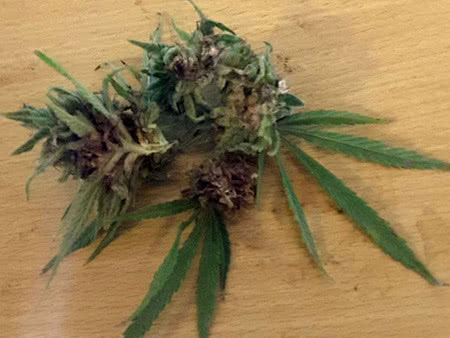
Equally important in preventing mold is the room used for drying buds once they are harvested. Think about this: In 2015, the HHE program visited an outdoor cannabis farm in Washington State during harvest to evaluate potential hazards. They found that Botrytis cinerea was the main fungal species in the air.[6]
Causes
More often than not, the problem is humidity-related.
Drying room issues
Buds drying in a room that’s too humid or in polluted airspace are an easy target for mold.
Buds were put away wet
Big buds take longer to dry than popcorn nuggets. Getting the batch evenly dried will help prevent moisture release in storage, which leads to mold infection.
Bad storage containers
The usual suspects are zip baggies and pickle jars, both of which are not airtight.

Quick Drying
Traditional slow drying and curing methods are great for bud quality. That all goes out the window once mold appears. It’s better to take a hit in quality by quick drying than to lose it all to mold.
The fastest way to dry buds is to break them all down off the branches and put them on drying racks or screens in a warm, dry location. You’ll lose the shape of the bud you would have had if they were hang dried.
💧 Dry out the air to dry out the buds. Relative humidity should be less than 45%
Dehumidifiers can lower the humidity of a room fast. However, overuse is known to make buds burn unevenly.
🌡️ Turning up the heat will speed up the drying process as well. Although too much heat will degrade cannabinoids and terpenes. Keep it under 80°F for minimal degradation.
Most hygrometers for sale have built-in thermometers like this one on Amazon so that you can measure the temperature and humidity of the drying room on the same device.
💨 Fans can be used to create a gentle breeze for drying buds. Mold should be picked out of buds before using fans to prevent spores from spreading.
Salvage Buds: Desperation Methods
If the steps taken above are still not enough to control your gray mold problem, here are some last resort desperation methods for salvaging buds—to be used with caution.
- Drying buds in the sun
- Drying buds with high temps
- Cooked in edibles, oils
- Ice water extraction followed by an alcohol extraction
- Make quick-wash iso hash (QWISO)
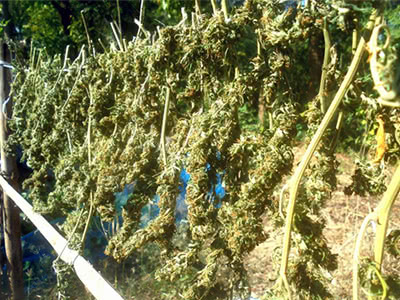
Exposing cannabis to solar radiation is known to cause THC loss and other cannabinoid degradation.[12] Still, it is a common practice for many growers in tropical areas around the world without access to power. A DIY method to circumvent the loss in bud quality is to make a wood stove that doesn’t need to burn hot to create a draft and drastically reduce the room’s humidity.
Is smoking gray mold harmful to humans?
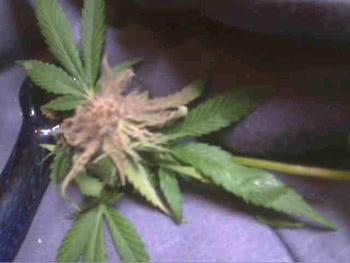
Although no mycotoxins have been reported from Botrytis, it is still not recommended to smoke affected marijuana or concentrates. Precautions should be taken when handling moldy cannabis buds, such as wearing face protection. When a bag of moldy buds is opened up, a cloud filled with innumerable mold spores is released.
A medical condition known as Winegrower’s lung is known to be caused by inhalation of Botrytis fungi. [2]
On the other hand, Botrytis cinerea is regularly consumed in wines. “Noble rot” is what winemakers call Botrytis, and there are highly-valued dessert wines made with the fungus.[7]

How do buds get ruined by mold?
Bud density
Cannabis buds bulk up in density during the end of their life cycle. The loss of intra-floral ventilation due to buds increasing in size combined with high humidity makes them prime candidates for Botrytis cinerea spores searching for a host.
The hypersensitive response
Plants have evolved natural responses to combat pathogen attacks. One of the primary responses to pathogen attack is an oxidative burst that triggers hypersensitive cell death in and around the attacked area.[7] This is referred to as the hypersensitive response and is done to cut off the food supply and keep pathogens at bay confined to that part of the plant. However, Botrytis works as a necrotrophic pathogen to utilize the dead tissue created and multiply on it.[8]
In other words, the fungi can exploit a cannabis plant’s defense mechanism for its pathogenic growth.
Chemical attack
Botrytis cinerea facilitates the formation of powerful chemicals that destroy buds and cause necrosis in plants. This includes various low molecular weight metabolites such as botrydial, oxalic acid, and HSTs.[1]
The fungi produce small RNA (sRNA) molecules that cause gene silencing to suppress host immunity.[9]
Spread
The fungi spread rapidly. When disturbed, they release a cloud of infectious spores, further spreading the disease. Damage occurs not just on buds but also on stems at pruning wounds where it can rot through the entire stem.
The stigmatic fluid present in buds serves as a nutrient medium for airborne conidia to germinate on.[10]
How does Botrytis infection start?
The infection starts with a fungal spore landing on plant tissue. Plants may be attacked at any stage, but freshly injured areas and aging or dead tissue are preferred. The spores germinate in suitable conditions of temperatures approximately 60–77°F with high relative humidity.[11]
The fungus can maintain growth in a range of temperatures from 28–90°F, although growth is halted at the extremes.[4]
❄️ Cool temperatures may slow the disease down, but the disease continues to infect and spread as long as it is moist.
🏜️ Hot, dry weather with plenty of direct sunlight is perhaps the best solution to shut the disease down.
Bud Rot Sprays
Due to the nature of cannabis use (smoking), we do not recommend foliar spraying mature buds with fungicides or other solutions. However, if the outbreak is caught early on, an organic fungicide such as Trifecta Crop Control may prove effective.
Cannabis Strains Resistant to Mold
Tropical sativa strains are highly resistant to gray mold. These mold resistant strains have often developed the resistance naturally, through many generations of growing in wet, humid climates. Their airy buds allow air to flow within, and damaged buds tend only to turn brown and rot instead of harboring gray mold.
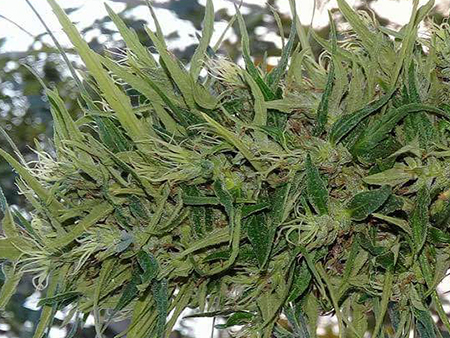
Landrace strains from Thailand, Laos, Cambodia, Vietnam are very resistant to gray mold. These long flowering sativa strains are fun to try if you’re growing in a tropical area but are difficult to manage indoors or outdoors in temperate climates.
Read our list—8 Resilient Mold Resistant Strains for sativas and hybrids that perform well-grown outdoors on the Big Island of Hawaii.
References
You may enjoy further learning about Botrytis cinerea through these links.
Disclaimer: We do not promote or undertake in illegal activity.

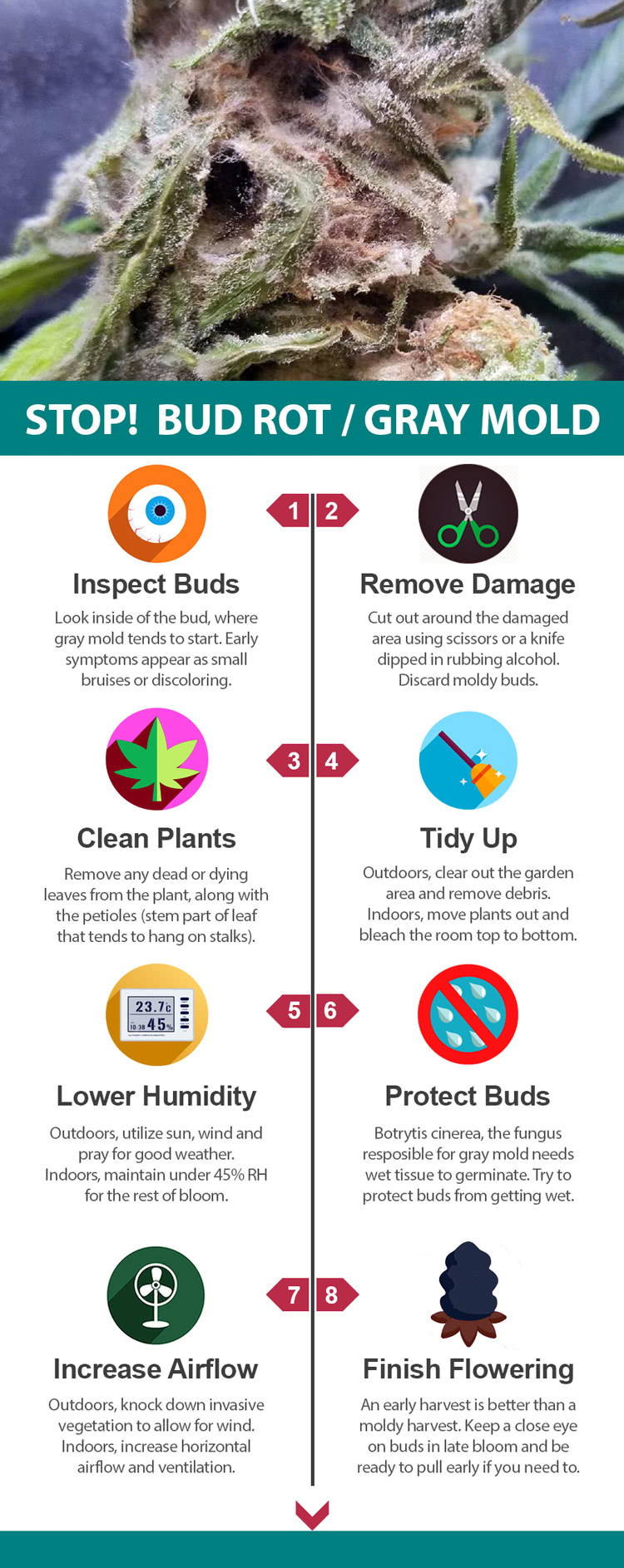
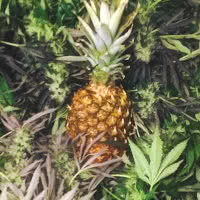
I have found that removing the effected bud and spraying with 3% H202 and saturating the infected area goes a long way towards stoping the spread of the fungus.
Hi Barrie, I heard this recently. My plants are in flowering stage, a week or two to harvest, and I’m concerned about getting h2o2 on the buds. Should I be?
Thanks,